

Desktop Plastic Extrusion System for Everyone by Edward Clifford. NEW - System adopts name FilaFab (Filament Fabricator).
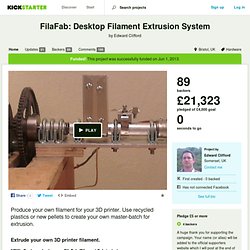
NEW - Take a look at the new videos added to the Update page. NEW - Be sure to check out the Updates for videos and info. Extrusion Rate: 1.2 meters/minute (47 inches/minute) (ABS at 170°C)Power Supply: 110-240VAC 50/60Hz Maximum Power Consumption: 250 Watts Average Power Consumption: 210 Watts Temperature Range: room temp (heater off) to 240°CExtrusion Temperature: 160°C - 180°C (optimal temperature varies with material) Tolerance @ 1.75mm: TBC Tolerance @ 3mm: TBC Extrude more than 280 meters in as little as 4 hours!!! I have been developing a low cost plastic extrusion system for many months now and am nearing completion. Www-g.eng.cam.ac.uk/impee/topics/RecyclePlastics/files/Recycling Plastic v3 PDF WITH NOTES.pdf. Filament Extruder inconclusiveness. Filament Extruder - Convert pellets to filament (Page 1) — Projects — SoliForum - 3D Printing Community. So, like most people, I've been surprised at how much filament costs, compared to raw plastic.
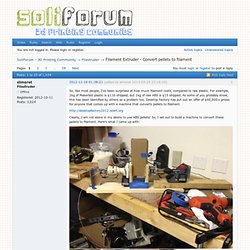
For example, 2kg of Makerbot plastic is $110 shipped, but 1kg of raw ABS is $15 shipped. As some of you probably know, this has been identified by others as a problem too. Desktop Factory has put out an offer of $40,000+ prizes for anyone that comes up with a machine that converts pellets to filament. Clearly, I am not alone in my desire to use ABS pellets! So, I set out to build a machine to convert these pellets to filament. Das Band - Fine Polyethylene Extruder. Raman Spectography for plastic ID. Automated Sorting of Plastics for Recycling. RECYCLING. Making ABS powder suggestion. RecycleBot v2.3 Controls by jpearce. The mechanical design is equivalent to RecycleBot v.2.2 - I strongly recommend reading that first.

This design is, of course, far from optimized particularly with respect to cost and DYI, it is primarily being used by the Michigan Tech in Open Sustainability Technology Research Group to make new fucntionalized 3-D printing materials (e.g. electrically conductive) to support a full range of products open-source disributed manufacturing...lots more to come. Some of the improved features over RecycleBot v2.2 are: 1.
Type of plastic can be selected from the keypad interface and the controller automatically updates the extrusion temperature for the plastic. 2. Extrusion temperature can also be feed by the keypad interface for any type of plastic which can be melted and extruded. 3. LCD interface for better process monitoring. 4. The energy performance of v2.2 can also be significantly improved with insulation. Www.plasticredesignproject.org/files/NWRecyclePsntn.pdf. Eco School Products Eco School Products provide oudoor classrooms, play equipment and learning tools made from recycled plastic and other sustainable materials.
How an 83-Year-Old Inventor Beat the High Cost of 3D Printing. If there were an award for Emerging Gadget Most Likely to Change Everything, it might well go to the 3D printer.

These devices, which turn digital blueprints into physical objects made out of plastic or other materials, are getting better, simpler and cheaper at such a dizzying pace that it’s not hard to imagine a future in which they’re as pervasive as PCs. Already, you can buy a basic desktop model for under $500. It’s dangerous, however, to get too hung up on the sticker prices of the 3D printers themselves.
Just as most of the cost of conventional ink-jet printing comes in the form of those pricey ink cartridges, the spools of plastic filament which a 3D printer layers into an object have a huge impact on the long-term economics of 3D printing. Inventables A spool of plastic filament for 3D printing The foundation focuses its efforts on entrepreneurship and education, and is already deeply involved in the maker community though activities such as participation in Maker Faires.
3D Printonomics: Going Super-Green: $0.10/kg! Taiwan tests recycling's limits with bus stops out of bottles. 28 February 2013Last updated at 19:03 ET By Katia Moskvitch Technology reporter, BBC News Arthur Huang shows how the new factory will be built "It will rise from trash," says the smiling young man sporting a white safety helmet, as he points to the bustling construction site behind him, near the raging sea.
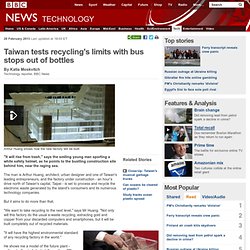
The man is Arthur Huang, architect, urban designer and one of Taiwan's leading entrepreneurs, and the factory under construction - an hour's drive north of Taiwan's capital, Taipei - is set to process and recycle the electronic waste generated by the island's consumers and its numerous technology companies. RecycleBot turns old milk jugs into 3D printer feedstock. Mar.2, 2013 The DIY movement has vaulted from the home to the research lab, and it's driven by the same motives: saving tons of money and getting precisely what you want.

Using open source software and 3D printers Michigan Technological University's Joshua Pearce has saved thousands of dollars by making everything from his lab equipment to his safety razor. "One impediment to even more widespread use has been the cost of filament," says Pearce, an associate professor of materials science and engineering and electrical and computer engineering. Though using 3D printing and open source software saves a lot of costs, the plastic filament that 3D printers use for making useful objects isn't cheap.
Household polymer waste, such as milk jugs, on the other hand, are a costly nuisance, either to recycle or to bury in a landfill. Superfine plastic powder pulverizing machine,View plastic pulverizing machine,Haifei Product Details from Zhangjiagang City Haifei Machinery Co., Ltd. on Alibaba.com. Polylactic acid log. December Year end collaborator update January Finalize literature review/ background information Transwiki to appropedia Finalize necessary equipment and materials Communicate with Pearce group to determine available equipment Cost of materials to be purchased - create estimated budget.
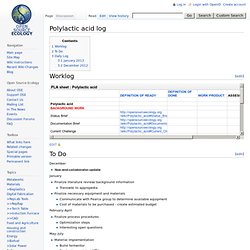
“Endless” Chair 3D printed: Robotic Arm and Recycled materials - 3D Printing. FilaMaker. DIY mini shredder - how to make one Part 1. 3th test of mini DIY shredder with Sonyericsson. Gaspard Bos - Industrial Design Engineering. Making jewelry out of waste materials with a 3D printer. Aug.20, 2012 Last weekend at Lowlands 2012 (One of largest and most famous Dutch pop festivals organized by Mojo Concerts) a nice project was presented that allowed visitors to turn their disposable cups into something beautiful with a 3D printer.
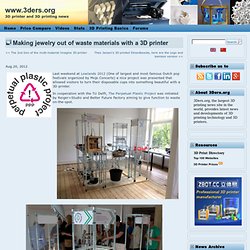
In cooperation with the TU Delft, The Perpetual Plastic Project was initiated by Reiger+Studio and Better Future Factory aiming to give function to waste on-the-spot. At Lowlands 2012, visitors were invited to operate the machines themselves, join the whole working process from washing, drying, shredding and melting of the disposable cups and to extrude it as material for 3D printer (Ultimaker). The Perpetual Plastic Project has two goals: the recycling of plastic at the local level by the consumer and to create awareness and their own thoughts about for consumption and production. (Images credit: Perpetual Plastic Project) Developing a plastics recycling add-on for the RepRap 3D printer. Waste plastic extruder. Note: The technology on this page is now out of data -- see Recyclebot version 2.3 for up-to-date information.
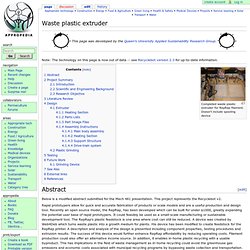
Completed waste plastic extruder for RepRap filament. Doesn't include spooling device Below is a modified abstract submitted for the Mech 461 presentation. This project represents the Recyclebot v2. Rapid prototypers allow for quick and accurate fabrication of products or scale models and are a useful production and design tool. As part of the Queen's University Mechanical Engineering course, Mech 461, I will be working on a device to convert household plastic waste into usable material to be fed into small scale rapid prototyping machines, such as the RepRap, RapMan and Fab@home machines.
[edit] Introduction. BPF: British Plastics Federation - Plastics Recycling. Login Join the BPF Join the BPF Mailing List Plastics Recycling Nearly all types of plastics can be recycled, however the extent to which they are recycled depends upon technical, economic and logistic factors.
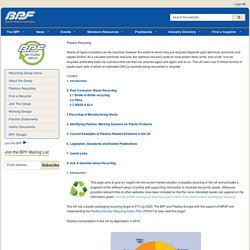
Preparing Biodegradable PLA for Powder-Based Rapid Prototyping. Developmental Extrusion Process ‘Spins’ Powder. By Jan H. Schut When you grind plastic cryogenically into powder, it has microscopic sharp edges and angles, which lower bulk density and processability. Cryogenic grinding is also expensive and energy consuming. Theoretically if you could extrude micropellets five or ten times smaller than conventional micropellets, you would have round powder with higher bulk density and better processability. That’s what Tim Osswald, a professor at the polymer engineering center at the University of Wisconsin-Madison, thought when he got an idea for extruding powder. Distributed Recycling of Waste Polymer into RepRap Feedstock. Christian Baechler, Matthew DeVuono, and Joshua M. Pearce, “Distributed Recycling of Waste Polymer into RepRap Feedstock” Rapid PrototypingJournal Stucker, 2010; Petrovic, et al., 2010; Gebhardt, et al., 2010; Crane, et al., 2011).
Recently an open source(OS) model, the RepRap, has been developed which can be built for under $1000, greatly expanding thepotential user base of rapid prototypers. The RepRap was created by Adrian Bowyer and influenced bymany contributors (Jones et al., 2011) including similar models such as the Fab@home (Malone andLipson, 2007).